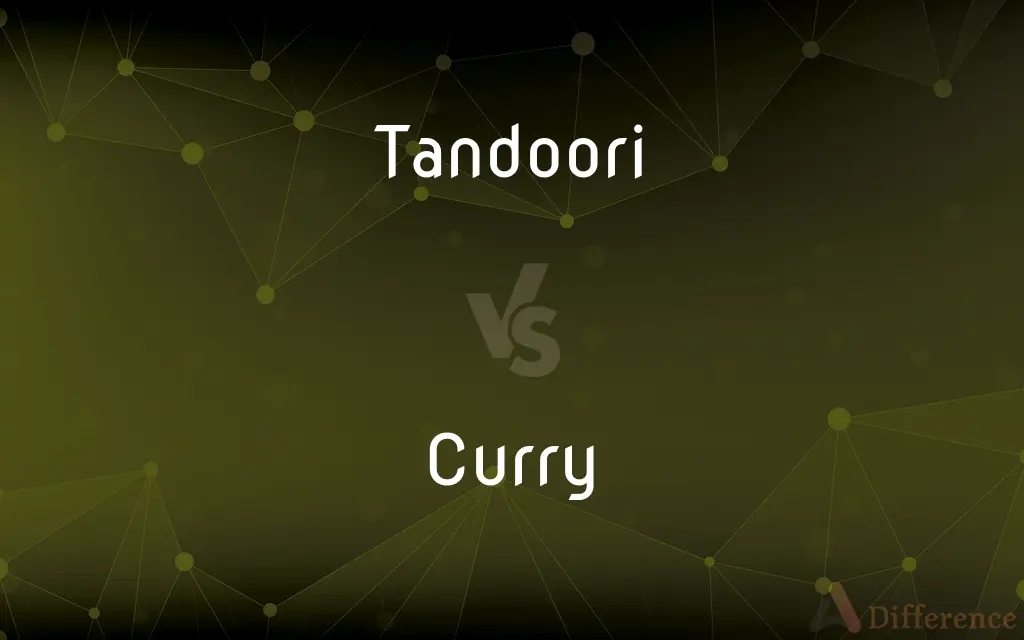Tandoori vs. Curry — What's the Difference?
By Urooj Arif & Maham Liaqat — Updated on April 27, 2024
Tandoori is a cooking method using a clay oven, while curry refers to a variety of spiced dishes cooked in a sauce.

Difference Between Tandoori and Curry
Table of Contents
ADVERTISEMENT
Key Differences
Tandoori cooking involves marinating ingredients, typically meat, in spices and yogurt, then cooking them at high temperatures in a clay oven known as a tandoor. On the other hand, curry encompasses a broader range of dishes that are typically prepared by cooking ingredients in a combination of spices and a liquid base, often including tomatoes, coconut milk, or yogurt.
The hallmark of tandoori cuisine is its smoky flavor and charred appearance, achieved by the intense heat of the tandoor. Whereas, curry dishes are known for their complex flavors and vibrant sauces, which result from the slow simmering of spices and ingredients.
Tandoori dishes are often characterized by their bright red or orange color, derived from spices such as cayenne pepper and paprika, mixed into the marinade. Conversely, the color of curry dishes can vary widely depending on the spices used, ranging from yellow to red to green.
While tandoori is specifically linked to the type of equipment used (the tandoor oven) and is primarily found in North Indian cuisine, curry is a ubiquitous style of dish found in various forms across India and other parts of the world, adapted to local tastes and available ingredients.
Nutritionally, tandoori dishes are generally lower in calories and fat since they are grilled and excess fat drips away, making them a healthier option. Curry, depending on its ingredients and preparation method, can be richer and more caloric due to the use of creamy sauces.
ADVERTISEMENT
Comparison Chart
Cooking Method
Cooked in a clay oven (tandoor)
Cooked in a pot or pan, usually simmered
Main Ingredients
Meats, yogurt, spices
Variety of meats, vegetables, spices, liquid
Flavor
Smoky, charred
Spicy, savory, varies by type
Color
Red, orange due to marinade
Varies (yellow, red, green) depending on spices
Cultural Origin
North Indian
Pan-Indian and global
Compare with Definitions
Tandoori
Clay Oven Cooking: A method of cooking in a clay oven, imparting a distinctive smoky flavor.
Tandoori chicken is famous for its smoky taste and vibrant color.
Curry
Variety of Spices: Utilizes a complex blend of spices for flavoring.
Curry powder, a mix of turmeric, cumin, and coriander, is essential for making curry.
Tandoori
Marinated Meats: Meats marinated in spices and yogurt before cooking.
The chicken for tandoori is marinated overnight to deepen the flavors.
Curry
Color Variations: The color can indicate the type of curry, such as green, red, or yellow.
Green curry is made using fresh green chilies.
Tandoori
High-Temperature Cooking: Cooked at high temperatures which sear the meat quickly.
Tandoori naan bread puffs up quickly due to the intense heat.
Curry
Simmered Dish: Typically simmered to allow flavors to meld.
The beef in the curry is simmered until tender.
Tandoori
North Indian Origin: Primarily associated with North Indian cuisine.
Tandoori roti is a staple in many North Indian households.
Curry
Curry is a variety of dishes originating in the Indian subcontinent. It uses a combination of spices or herbs, usually including ground turmeric, cumin, coriander, ginger, and fresh or dried chilies.
Tandoori
Charred Appearance: Often has a charred exterior due to the high cooking temperatures.
The edges of tandoori chicken are slightly charred but delicious.
Curry
To groom (a horse) with a currycomb.
Tandoori
Cooked in a tandoor.
Curry
To prepare (tanned hides) for use, as by soaking or coloring.
Tandoori
(of food) Cooked in a tandoor.
Curry
To season (food) with curry.
Tandoori
(of food) A dish that was cooked in a tandoor.
Curry
A dish of meat or vegetables flavored with pungent spices, typical of South Asian and Southeast Asian cuisines.
Curry
A blend of spices used in or suggesting the flavor of curry, typically containing turmeric, cumin, coriander, and ginger, among other ingredients.
Curry
Curry powder.
Curry
One of a family of dishes originating from Indian cuisine, flavoured by a spiced sauce.
Curry
A spiced sauce or relish, especially one flavoured with curry powder.
Curry
Curry powder.
Curry
(transitive) To cook or season with curry powder.
Curry
(transitive) To groom (a horse); to dress or rub down a horse with a curry comb.
Curry
(transitive) To dress (leather) after it is tanned by beating, rubbing, scraping and colouring.
Curry
(transitive) To beat, thrash; to drub.
Curry
(transitive) To try to win or gain (favour) by flattering.
Curry
To perform currying upon.
Curry
To scurry; to ride or run hastily
Curry
To cover (a distance); (of a projectile) to traverse (its range).
Curry
To hurry.
Curry
To dress or prepare for use by a process of scraping, cleansing, beating, smoothing, and coloring; - said of leather.
Curry
To dress the hair or coat of (a horse, ox, or the like) with a currycomb and brush; to comb, as a horse, in order to make clean.
Your short horse is soon curried.
Curry
To beat or bruise; to drub; - said of persons.
I have seen him curry a fellow's carcass handsomely.
Curry
To flavor or cook with curry.
Curry
A kind of sauce much used in India, containing garlic, pepper, ginger, and other strong spices.
Curry
A stew of fowl, fish, or game, cooked with curry.
Curry
(East Indian cookery) a pungent dish of vegetables or meats flavored with curry powder and usually eaten with rice
Curry
Season with a mixture of spices; typical of Indian cooking
Curry
Treat by incorporating fat;
Curry tanned leather
Curry
Give a neat appearance to;
Groom the dogs
Dress the horses
Curry
Spiced Sauce: Dishes consisting of vegetables or meats cooked in a spiced sauce.
Chicken curry is made with a base of onions, tomatoes, and spices.
Curry
Global Variations: Adapted globally with variations in ingredients and spices.
Thai curries use coconut milk for a creamy texture.
Common Curiosities
Can curry be considered a type of tandoori?
No, curry is not a type of tandoori; they are distinct in preparation and flavor.
Is curry typically vegetarian or non-vegetarian?
Curry can be both vegetarian and non-vegetarian, depending on the ingredients used.
What is the main cooking equipment for tandoori?
Tandoori dishes are cooked in a clay oven called a tandoor.
How does the spice level of tandoori compare to curry?
Both can be spicy, but the spice level can be adjusted in both dishes according to taste.
What is a common side dish for tandoori?
Naan bread or rice is commonly served with tandoori dishes.
Can tandoori dishes be made in a regular oven?
Yes, though the traditional smoky flavor may be less pronounced without a clay oven.
Is it possible to prepare a vegan curry?
Yes, many curries can be made vegan by substituting plant-based ingredients for meat and dairy.
Are there specific regions in India where curry or tandoori are more popular?
Tandoori is particularly popular in North India, while curry is popular nationwide and varies regionally.
What types of meats can be used in tandoori cooking?
Commonly, chicken, lamb, and fish are used in tandoori recipes.
What is a common ingredient in curry that is rarely used in tandoori?
Coconut milk is commonly used in many types of curry but not in tandoori.
What's the typical preparation time for tandoori dishes compared to curry?
Tandoori requires marinating time, often overnight, plus quick cooking, whereas curry might require longer simmering times.
What makes tandoori color so vibrant?
The vibrant color comes from spices like paprika and turmeric used in the marinade.
Are curries always made with a creamy base?
Not always; some curries are tomato-based or water-based, without cream.
How are the spices used differently in tandoori versus curry?
In tandoori, spices are used in a dry marinade, while in curry, they are often cooked to form a sauce.
How does the taste of a curry change with different spices?
The choice of spices can make a curry taste earthy, sweet, or fiery, significantly influencing the dish's overall flavor profile.
Share Your Discovery

Previous Comparison
Immortal vs. Eternal
Next Comparison
Speck vs. SpeakAuthor Spotlight
Written by
Urooj ArifUrooj is a skilled content writer at Ask Difference, known for her exceptional ability to simplify complex topics into engaging and informative content. With a passion for research and a flair for clear, concise writing, she consistently delivers articles that resonate with our diverse audience.
Co-written by
Maham Liaqat













































